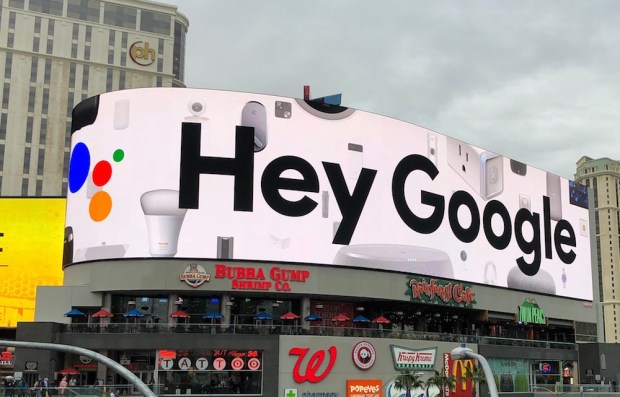Everybody Wants To Rule The (Smart Speaker) World

Amazon, undeniably, has the early lead in the race for smart speaker dominance. Its Echo line of products powered by Alexa — the voice-activated, artificially intelligent brains behind the operation — has 25,000 skills, 25,000 developers and commands roughly 70 percent of the home smart speaker market today. Experts estimate that Echo/Alexa will be worth $10 billion to $11 billion in incremental sales for Amazon over the next three years.
But the race is still early.
The PYMNTS/Visa How We Will Pay study in June of 2017 revealed that only about 15 percent of consumers owned a smart speaker device, giving them roughly the same market penetration as smartwatches, despite being in the game twice as long. Given the wide-ranging reports that Amazon Echo devices had a banner holiday sales season, we can only assume that figure has increased.
2017 was also the year when smart speakers started demonstrating “hockey-sticking” — the standard for something really igniting. Smart speakers have also grossly outpaced the growth of technologies that have entered the market with a good deal more fanfare over the last several years but haven’t gotten anywhere close to the same level of traction — think drones and virtual reality headsets.
The How We Will Pay study also revealed that consumers who own smart speakers are exponentially more valuable: The data indicates they both shop more often and spend more via those devices — which likely explains the full-court press the world of smart speakers made this week at The International Consumer Electronics Show (CES).
“Pretty quickly, compatibility with these [digital] assistants has become table stakes,” said Steve Koenig, senior director of research at the Consumer Technology Association, in a presentation in Las Vegas on Sunday. “2017 was a huge year for smart speakers.”
And 2018 was a huge year for smart speakers making their case to the masses at CES — possibly second only to connected cars (and the host of innovations and upgrades that are apparently on deck).
Google’s Gaggle of Releases
As the second half of 2017 kicked off, Amazon gained two big Silicon Valley rivals in the home speaker race.
Apple announced the launch of its forthcoming (and pricey) HomePod for holiday 2017. But by the time it was beginning to look a lot like Christmas, Apple said it would sit out the race. Apple’s AWOL status on that front continued through CES this year, prompting snarky headline writers to inquire, “Hey, Siri, Where Are You?”
Skipping CES is nothing new for Apple; they prefer to launch their innovations from the comfort of the Steve Jobs auditorium, but commentators noted that this year might have been the time to make an appearance.
Just ask Google.
According to reports, it was hard to look in a straight line in any direction in Las Vegas this week without seeing the phrase, “Hey Google.” The signage was everywhere, painted — in bright, bold colors — on billboards, a giant tent and even the Las Vegas monorail.
Google also decided to double down on the “with a little help from its friends” strategy that it first pursued in late 2017. Its first round was about pairing up with a vast swath of retailers to provide commerce services — who were eager to jump into the world of voice-activated commerce, but less excited to do so on a platform operated and controlled by Amazon.
It seems this next round is about flooding the market with a host of devices of varying levels of complexity and quality that are all ready to respond as soon as they hear the magic words: “Okay, Google.”
At CES this week, Google announced partnerships with 15 companies to make new smart speakers and appliances, including four devices that will have built-in screens.
Those devices with screens aren’t Android — Google’s mobile operating system — but instead Google Things, the company’s software specifically built for in-home devices.
Joining the Google family of smart, connected speakers will be devices built by Altec Lansing, Anker Innovations, Bang & Olufsen, Braven, iHome, JBL, Jensen, Lenovo, LG, Klipsch, Knit Audio, Memorex, RIVA Audio, SōLIS Audio and Sony. Those speakers will be constructed in various — and in some cases Echo-reminiscent — forms. LG is focusing on high-quality sound.
LG — along with JBL, Lenovo and Sony — will also be offering speakers with screens built in, which they’re calling smart displays. The functionality is similar to that of the Echo Show — Amazon’s smart screen-bearing smart speaker. Unsurprisingly, Google did not make reference to the similarity when explaining the reasons it’s collaborating with device makers to add a screen to its hardware.
“There are also moments when a screen would make the Assistant even more helpful, like when you need to learn how to cut a pineapple,” noted Google Assistant Vice President Scott Huffman during the device’s rollout.
Google’s speaker lineup was buttressed by its expanding line of in-home items that can be controlled via its speakers. LG’s new TVs will have Google Assistant inside, and GE has built a way to ask Google Assistant (and Alexa) to preheat an oven or turn on the dishwasher remotely.
However, while Google made the biggest press, it was not alone.
The Field
Amazon Alexa and Google were everywhere at CES, but Samsung made it very clear that they — along with their virtual assistant Bixby — are quite the contenders.
“By 2020, all Samsung connected devices will not only be IoT ready, they will also be intelligent,” promised HS Kim, head of Samsung’s Consumer Electronics Division, in his remarks at the outset of the event.
Amazon and Google have larger ecosystems, but Bixby comes care of a very large network of devices that span the gamut of already-established use cases — both in consumers’ personal lives at home and in their professional lives at work. Rather than be entirely dedicated to keeping customers locked to its wide ecosystems of electronics, Samsung announced third-party device support for Bixby.
Also competing at the CES party this week was Baidu — the firm known internationally as the Chinese Google.
As of 2018, Baidu also wants to be known as the operator of the Chinese Alexa, as it used the event to roll out three new smart home devices: the Little Fish VSI Smart Speaker, the Sengled Smart Lamp Speaker and the PopIn Aladdin.
All three are designed to respond to voice commands, answer questions and interact with smart appliances and other smart home equipment. The devices can also be used to stream media, can function as lamps and one even has a dome light that doubles as a projector.
However, none of these devices are currently slated for U.S. release — though all three will be available in both China and Japan.
Even Cortana — Microsoft’s often-overlooked voice assistant — made an appearance at CES. Apparently, it’s the brains behind the “most beautiful thermostat ever made.”
But, of course, at the end of the day, Amazon and Alexa still loomed large over the field with its 70 percent market share, two-year headstart, name recognition, consumer affection and 25,000 skills supported by an army of 25,000 developers.
Amazon didn’t have new devices to roll out at the event. Instead, the company focused on the massive expansions Alexa is making. Those leaps were most apparent when it came to automotive expansion — as Alexa has found a remarkable number of ways to get on the road with consumers — but, like Google, it was also present throughout the announcement of a variety of smart devices and appliances.
The race for AI-enabled smart speakers may still be in early days, but those early days are rapidly coming to a close as the participants are picking up their pace and expanding their ambitions.
